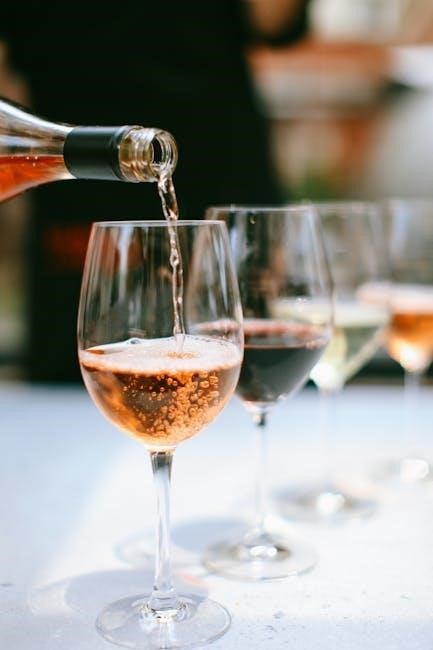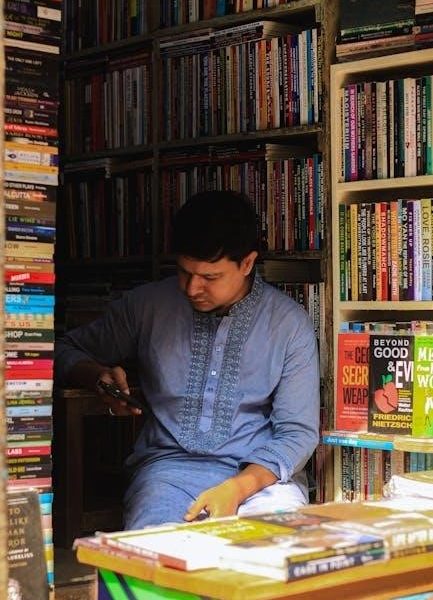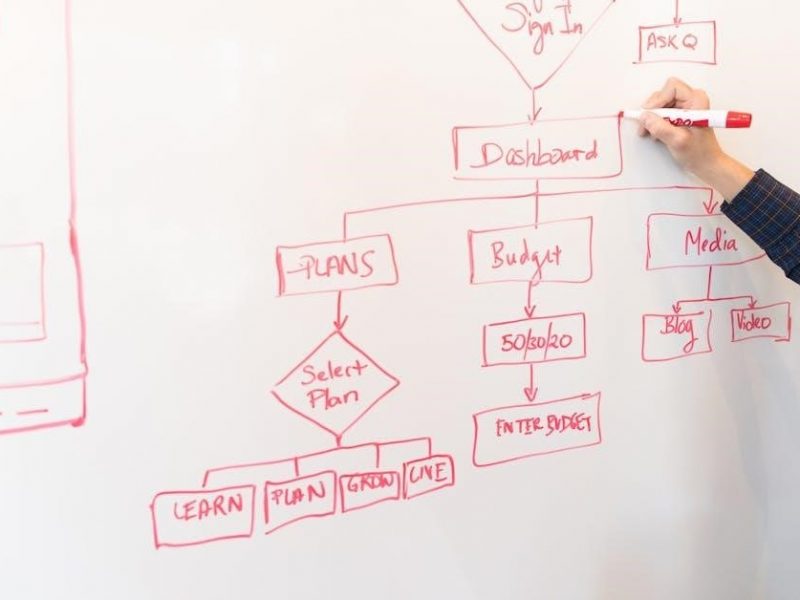A blind wine tasting sheet is a tool for unbiased wine evaluation‚ helping tasters systematically document observations and enhance sensory skills through structured‚ consistent assessment.
1.1 What is a Blind Wine Tasting Sheet?
A blind wine tasting sheet is a structured tool designed to guide individuals in evaluating wines without knowing their identity. It typically includes sections for documenting appearance‚ aroma‚ palate‚ and finish‚ allowing tasters to focus on sensory observations rather than preconceived notions about the wine; The sheet often features customizable fields to suit individual or group preferences‚ enabling systematic and unbiased analysis. By removing label influences‚ it encourages a deeper connection to the wine’s characteristics‚ making it an essential resource for both casual enthusiasts and professionals. The format may vary‚ but its core purpose remains consistent: to enhance the tasting experience and provide a clear framework for assessment.
1.2 Purpose of the Sheet
The primary purpose of a blind wine tasting sheet is to facilitate unbiased and structured wine evaluation. By removing the influence of labels‚ it encourages tasters to focus solely on sensory characteristics‚ fostering a deeper understanding of the wine’s true qualities. The sheet serves as a practical tool for documenting observations‚ ensuring consistency in assessment and aiding in the identification of patterns or preferences. It is particularly valuable in educational settings‚ such as professional exams‚ where precise and objective evaluation is crucial. Additionally‚ it enhances the overall tasting experience‚ making it more engaging and informative for both novice and experienced wine enthusiasts. The sheet’s design promotes systematic analysis‚ helping users refine their palate and develop a more discerning approach to wine appreciation.
Structure of the Tasting Sheet
The tasting sheet typically follows a grid format‚ organizing sections like appearance‚ aroma‚ palate‚ and finish. This structure ensures systematic and standardized documentation of the tasting experience.
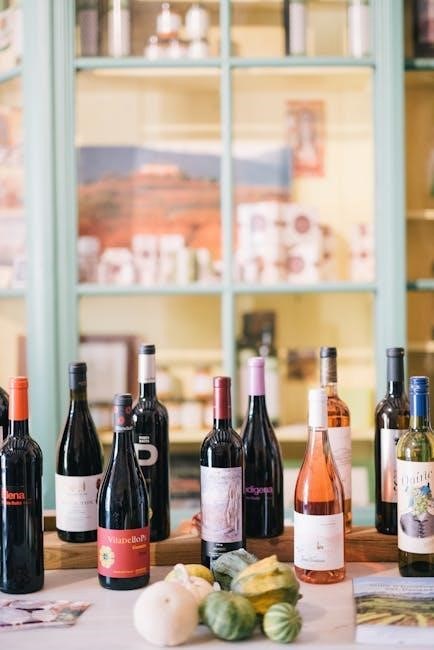
2.1 Typical Sections Included
A blind wine tasting sheet typically includes sections for appearance‚ aroma‚ palate‚ and finish. These categories allow tasters to systematically evaluate the wine’s characteristics. The appearance section often assesses color‚ clarity‚ and viscosity. The aroma section may include descriptors for fruit‚ floral‚ or earthy notes. Palate sections focus on texture‚ acidity‚ tannins‚ and body‚ while finish evaluates the lingering flavors and overall impression. Many sheets also incorporate a scoring system‚ enabling tasters to rate wines numerically. Additional sections might include space for guessing the wine’s origin‚ grape variety‚ or vintage. Some templates extend to detailed flavor profiles or oak influence assessments. These structured sections ensure comprehensive and unbiased documentation‚ aiding both novice and experienced tasters in organizing their observations effectively.
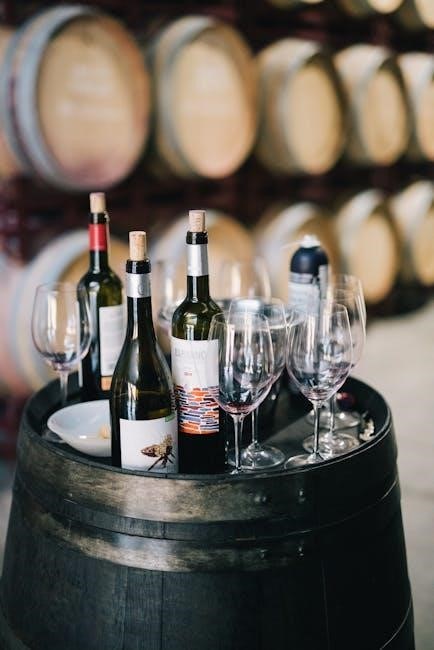
2.2 Customization Options
Blind wine tasting sheets can be tailored to suit individual preferences or specific tasting goals. Users may add or modify sections based on their expertise level‚ such as including detailed aroma descriptors or expanding the palate analysis. Some templates allow for adjustable scoring scales‚ enabling tasters to emphasize certain criteria like acidity or tannins. Additional fields for noting wine origins‚ grape varieties‚ or vintage guesses can enhance the educational aspect. Customization also extends to the design‚ with options to change layouts‚ colors‚ or fonts for better readability. Advanced users might incorporate charts or grids for comparative analysis‚ while beginners could simplify sections to focus on foundational elements. These customization options ensure the sheet adapts to various tasting scenarios‚ making it versatile for both personal use and professional events.
Criteria for Evaluation
Key criteria include appearance‚ aroma‚ palate‚ and finish‚ with detailed assessments of color‚ clarity‚ bouquet‚ flavor‚ tannins‚ acidity‚ and overall balance‚ ensuring comprehensive wine analysis.
3.1 Appearance‚ Aroma‚ Palate‚ Finish
The blind wine tasting sheet evaluates wines based on four primary criteria: appearance‚ aroma‚ palate‚ and finish. Appearance assessments focus on color‚ clarity‚ and viscosity‚ providing initial insights into the wine’s age and grape variety. Aroma evaluation examines the intensity and characteristics of the bouquet‚ ranging from fruity to floral or earthy notes. The palate section involves tasting‚ analyzing sweetness‚ acidity‚ tannins‚ and body‚ which collectively define the wine’s texture and balance. Finally‚ the finish refers to the lingering flavors and sensations after swallowing‚ indicating the wine’s complexity and quality. These criteria ensure a systematic and unbiased evaluation‚ helping tasters develop a deeper understanding of each wine’s unique profile.
3.2 How to Assess Each Criterion
Assessing each criterion requires a systematic approach. For appearance‚ observe the wine’s color‚ clarity‚ and viscosity‚ noting if it is pale‚ rich‚ or hazy. Aroma evaluation involves swirling the wine to release fragrances‚ then smelling to identify notes like citrus‚ spice‚ or earth. The palate is judged by tasting‚ focusing on sweetness‚ acidity‚ tannins‚ and body‚ which together define the wine’s texture and balance. Finally‚ the finish is evaluated by the lingering flavors and sensations after swallowing‚ with longer finishes indicating higher quality. Using a blind wine tasting sheet‚ tasters can methodically record these observations‚ ensuring a thorough and unbiased analysis of each wine’s characteristics.
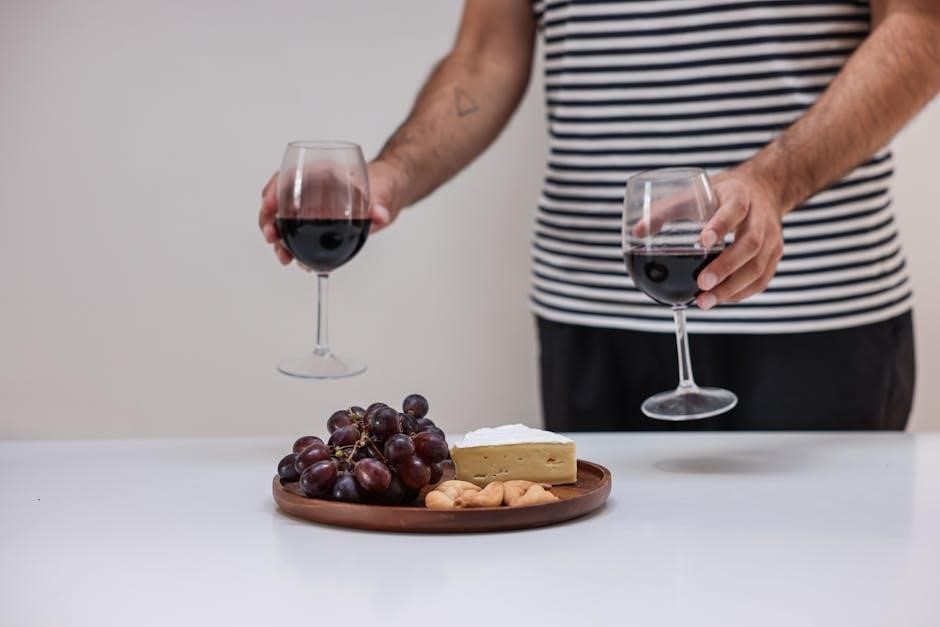
Scoring System
The scoring system in a blind wine tasting involves evaluating wines based on appearance‚ aroma‚ palate‚ and finish‚ with scores tallied to determine overall rankings and preferences systematically.
4.1 Methods for Scoring Wines
Scoring wines in a blind tasting involves systematic methods to evaluate and compare wines objectively. Common approaches include using a 100-point scale‚ where wines are rated based on appearance‚ aroma‚ palate‚ and finish. Each criterion is assessed individually‚ with points allocated accordingly: appearance (5 points)‚ aroma (10 points)‚ palate (40 points)‚ and finish (5 points). Total scores help rank wines‚ providing clarity in differentiation. Some methods also incorporate descriptors and checkboxes for specific characteristics‚ such as tannins‚ acidity‚ and oak influence‚ to enhance precision. Additionally‚ group tastings often use aggregated scores to determine collective preferences. These methods ensure consistency and fairness‚ making the blind tasting process both informative and enjoyable for participants. By focusing on detailed evaluation‚ scoring systems enhance the overall tasting experience and aid in identifying standout wines. This structured approach is widely used in professional exams and casual events alike‚ fostering a deeper understanding of wine profiles and nuances.
4;2 Interpreting Scores Effectively
Interpreting scores in a blind wine tasting requires understanding the scoring scale and its implications. Typically‚ wines are scored on a 100-point scale‚ with higher scores indicating better quality. Scores can be categorized as follows: 90-100 points for exceptional wines‚ 80-89 for good wines‚ and below 80 for average or poor wines. Each criterion—appearance‚ aroma‚ palate‚ and finish—contributes to the total score‚ with the palate often having the highest weight. By analyzing individual category scores‚ tasters can identify a wine’s strengths and weaknesses‚ such as a strong aroma but a disappointing finish. Consistency and context are crucial; comparing scores across wines and tasters helps validate results. Effective interpretation enhances understanding and aids in making informed decisions about wine preferences and quality. This method ensures that the blind tasting process remains objective and insightful for all participants. Accurate interpretation is key to maximizing the benefits of the scoring system.

Importance in Wine Education
A blind wine tasting sheet is essential for developing sensory skills‚ understanding wine characteristics‚ and preparing for professional exams‚ making it a vital tool in wine education and training.
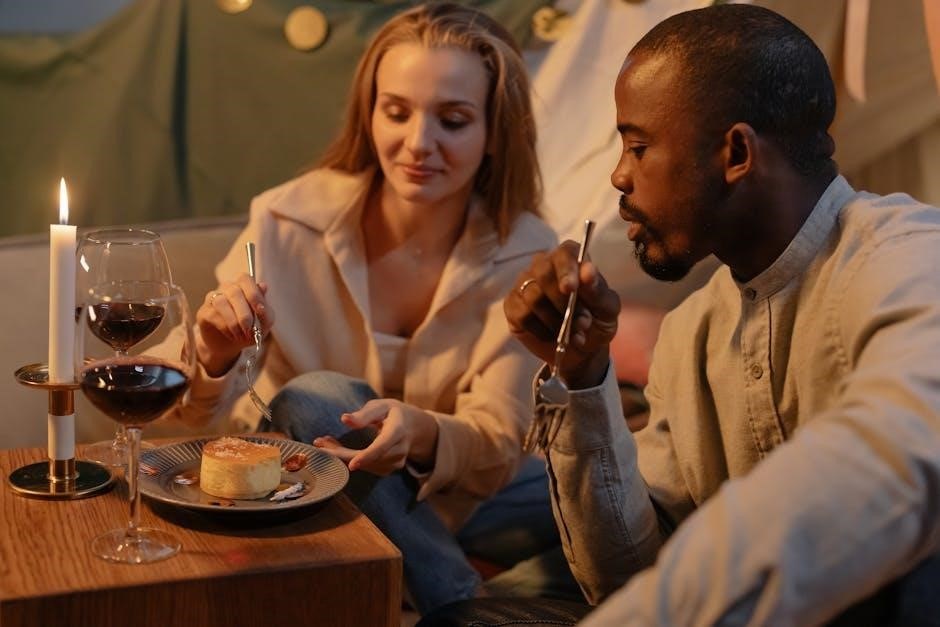
5.1 Role in Professional Exams
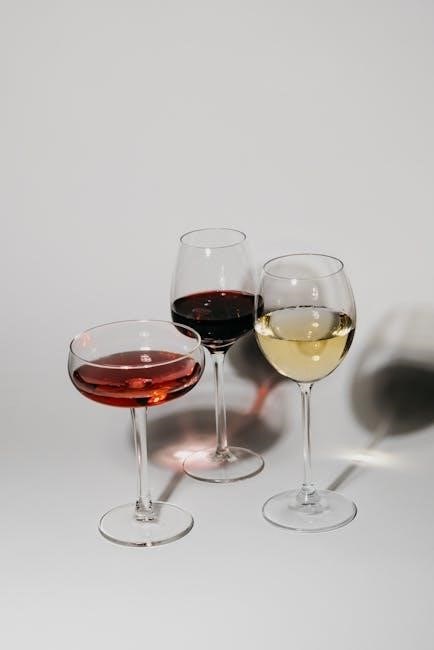
Blind wine tasting sheets play a crucial role in professional wine exams‚ such as the WSET Level 3 and Court of Master Sommeliers. These exams require candidates to accurately identify wines based on sensory evaluation. The sheet provides a structured format for assessing appearance‚ aroma‚ palate‚ and finish‚ ensuring unbiased and consistent evaluation; By practicing with these sheets‚ professionals refine their tasting skills‚ learning to identify key wine characteristics like tannins‚ acidity‚ and oak influence. This systematic approach enhances their ability to determine a wine’s origin‚ grape variety‚ and vintage‚ which are essential skills for sommeliers and wine experts. Regular use of blind tasting sheets prepares candidates for the high-pressure environment of professional exams‚ where precise descriptions and accurate conclusions are critical for success.
5.2 Enhancing Sensory Skills
Blind wine tasting sheets are invaluable for enhancing sensory skills‚ as they require tasters to rely solely on their senses rather than prior knowledge of the wine. By systematically evaluating appearance‚ aroma‚ palate‚ and finish‚ tasters develop a sharper awareness of subtle nuances in wine characteristics. Regular use of these sheets trains the palate to detect variations in acidity‚ tannins‚ and oak influence‚ as well as distinguish between fruit‚ floral‚ and earthy notes. Over time‚ this practice improves one’s ability to describe wines accurately and confidently. Experts like Sarah Looper emphasize that consistent practice‚ whether alone or in groups‚ refines sensory precision and builds a deeper understanding of wine complexity. This skill enhancement is particularly beneficial for both casual enthusiasts and professionals aiming to refine their tasting abilities.
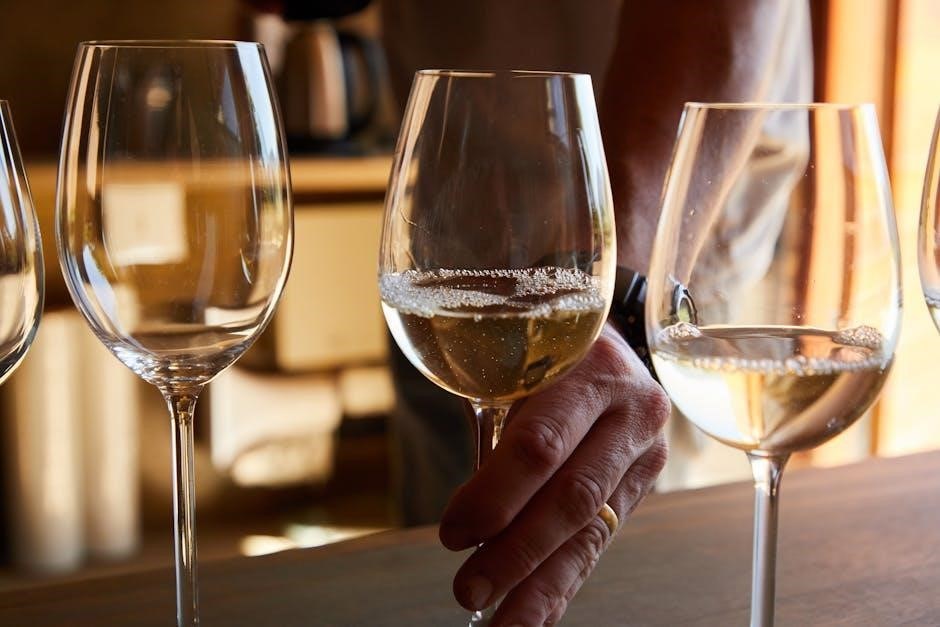
Hosting a Blind Tasting Event
Hosting a blind tasting event involves organizing wines‚ structuring the tasting process‚ and using sheets for documentation‚ ensuring a fun and educational experience for all participants.
6.1 Preparation Steps
Hosting a successful blind tasting event requires meticulous preparation. Start by selecting a variety of wines‚ ensuring they are wrapped or labeled anonymously to avoid bias. Prepare blind tasting sheets for each participant‚ including sections for appearance‚ aroma‚ palate‚ and finish. Set up a neutral environment with proper lighting and clean glassware for each wine. Provide water‚ bread‚ and spittoons to cleanse palates between tastings. Assign a facilitator to guide the process and maintain anonymity. Brief participants on the tasting criteria and scoring system to ensure consistency. Consider grouping wines by type or region to add structure. Finally‚ organize the wines in a random order to keep the tasting unbiased and engaging. Proper preparation ensures a smooth and enjoyable experience for all participants.
6.2 Managing the Tasting Experience
Managing the tasting experience ensures a seamless and enjoyable event. Begin by distributing the blind tasting sheets and explaining the evaluation criteria clearly. Encourage participants to taste wines in a predetermined order‚ allowing time for each wine to be assessed without rushing. Circulate among guests to answer questions and provide guidance while maintaining the anonymity of the wines. Use a scoreboard or digital tool to collect and tally scores discreetly. After all wines are tasted‚ reveal their identities‚ sharing insights and comparing notes. Foster a relaxed atmosphere‚ promoting discussion and learning. Effective management enhances participant engagement and ensures a memorable experience for all. Attention to detail and clear communication are key to a successful blind tasting event.
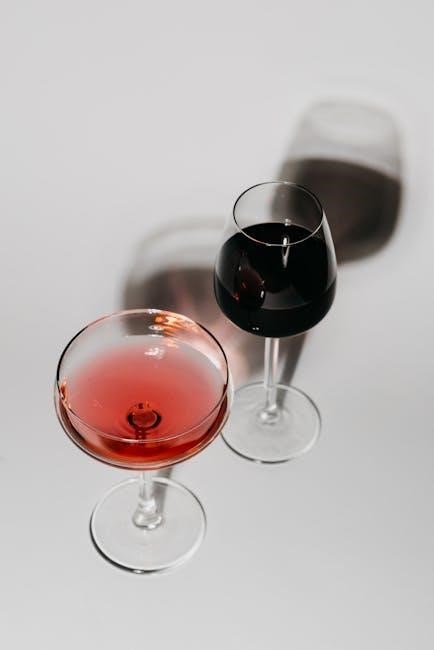
Resources and Templates
Discover comprehensive resources and customizable templates online‚ offering structured formats for blind wine tasting. Websites provide downloadable PDFs‚ including UMAMU Estate’s sheet‚ for easy editing and printing‚ enhancing your tasting experience.
7.1 Where to Find PDF Templates
Blind wine tasting sheet PDF templates are widely available online‚ offering convenient and customizable options for enthusiasts and professionals. Websites like UMAMU Estate provide downloadable sheets‚ while platforms such as DocHub allow easy editing and sharing. Google searches yield numerous free templates designed for blind tastings‚ often featuring structured sections for appearance‚ aroma‚ palate‚ and finish. Many wine communities and forums also share printable formats tailored for events or personal use. These templates are ideal for hosting wine tastings‚ enabling participants to systematically document their experiences. With a variety of designs to choose from‚ users can select templates that best suit their needs‚ whether for educational purposes or social gatherings. Printable PDFs ensure a seamless and organized approach to wine evaluation.
7.2 Creating Your Own Template
Creating a custom blind wine tasting sheet PDF allows for personalized structure and flexibility. Start by identifying essential sections like appearance‚ aroma‚ palate‚ and finish‚ ensuring each criterion is clearly defined. Tools like Microsoft Word or Google Docs can be used to design the layout. Include scoring systems‚ descriptive fields‚ and space for notes to capture detailed impressions. Customize fonts‚ colors‚ and spacing for readability. Add visual elements‚ such as color wheels or tasting grids‚ to enhance user experience. For events‚ incorporate placeholders for date‚ event name‚ or taster’s name. Consider adding a section for revealing wine details post-tasting. Save the template as a PDF for easy sharing and printing. This approach ensures the sheet aligns with specific tasting goals‚ making it versatile for both personal and professional use.
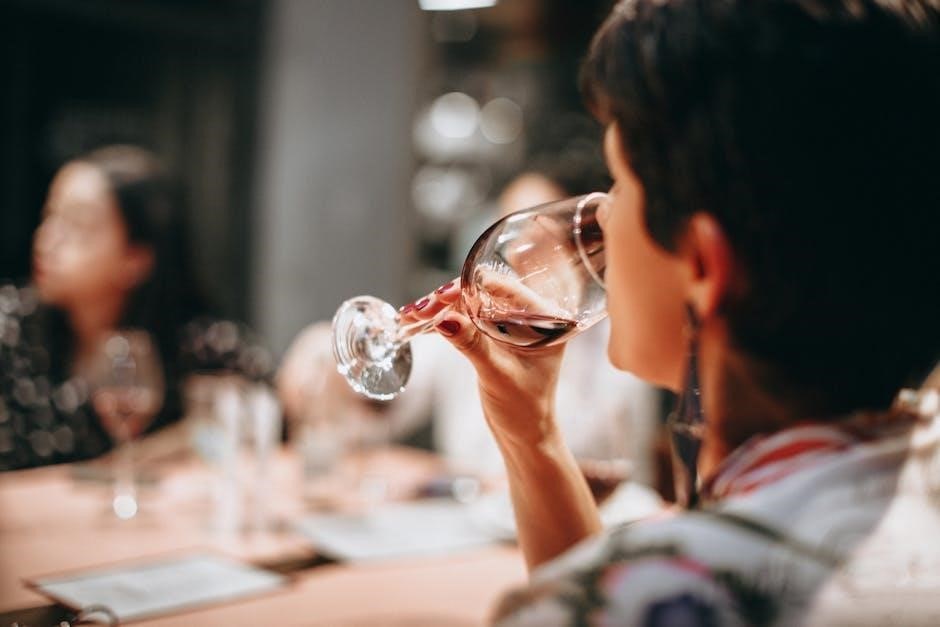
Tips for Effective Blind Tasting
Use neutral glassware‚ serve wines at correct temperatures‚ and provide water for palate cleansing. Trust instincts‚ avoid distractions‚ and systematically evaluate appearance‚ aroma‚ and palate.
8.1 Strategies for Accurate Tasting
To enhance accuracy in blind wine tasting‚ use a consistent tasting order‚ such as light to heavy wines. Ensure proper glassware and neutral conditions.
Evaluate appearance‚ aroma‚ and palate systematically‚ noting color‚ clarity‚ intensity‚ and texture. Trust your instincts and avoid distractions.
Use the 20-20-60 rule: 20% on appearance‚ 20% on aroma‚ and 60% on palate and finish. Record observations immediately to avoid bias.
Practice regularly to refine sensory skills and build confidence. Consider using a tasting grid for structured analysis.
Stay hydrated and avoid strong flavors before tasting; Blind tasting sheets can guide evaluation and improve focus during the process.
8.2 Avoiding Common Mistakes
Common mistakes in blind wine tasting include relying too heavily on preconceptions about labels or regions. To avoid this‚ focus solely on sensory observations.
Don’t rush the tasting—take time to evaluate appearance‚ aroma‚ and palate thoroughly. Avoid distractions and ensure the environment is neutral.
Never assume a wine’s identity based on a single characteristic; consider the overall balance and complexity. Proper glassware and serving temperatures are crucial.
Overlooking subtle flaws or exaggerating positive traits can skew results. Stay objective and use a structured tasting sheet for consistency.
Finally‚ avoid comparing wines side by side; evaluate each independently. By minimizing these errors‚ you can achieve more accurate and reliable assessments.
A blind wine tasting sheet is an essential tool for enhancing sensory skills‚ ensuring objective evaluations‚ and documenting experiences systematically. Its structured approach fosters deeper wine appreciation and confidence in assessments.
9.1 Summary of Benefits
A blind wine tasting sheet offers numerous benefits‚ primarily fostering unbiased wine evaluation and enhancing sensory skills through structured documentation. It allows tasters to rely solely on sensory experiences‚ free from label influences‚ ensuring objective assessments. The sheet’s systematic approach promotes consistency‚ enabling comparisons and tracking progress over time. For professionals‚ it serves as a vital tool in exams like WSET‚ while casual enthusiasts can use it to refine their palates. The availability of printable templates simplifies preparation‚ making it accessible for both personal use and hosting events. By focusing on appearance‚ aroma‚ palate‚ and finish‚ the sheet encourages detailed observation‚ fostering a deeper appreciation of wine complexity. Ultimately‚ it empowers tasters to make informed decisions‚ whether for education‚ enjoyment‚ or professional growth.
9.2 Encouragement to Use Sheets
Using a blind wine tasting sheet is a powerful way to elevate your wine tasting experiences and deepen your understanding of wine. It encourages a focus on sensory details‚ helping you develop a more nuanced palate and unbiased opinions. Whether you’re a professional or an enthusiast‚ these sheets provide a structured yet flexible framework for documenting observations‚ making comparisons‚ and tracking progress. They also serve as a practical tool for hosting engaging tasting events or practicing independently. By incorporating a blind tasting sheet into your routine‚ you’ll gain confidence in your ability to assess wines critically and discover new favorites. Embrace this approach to enhance your appreciation of wine and make every tasting session more rewarding and enjoyable.
Additional Resources
Explore books like The Wine Bible and online forums such as the wine community on Reddit for deeper insights and practical advice on blind wine tasting techniques and resources.
10.1 Books on Wine Tasting
For deeper insights into wine tasting‚ books like The Wine Bible by Karen MacNeil and The Oxford Companion to Wine by Jancis Robinson are invaluable. These texts provide comprehensive guides to understanding wine characteristics‚ regions‚ and tasting techniques. Wine & Spirit Education Trust (WSET) materials are also highly recommended for structured learning. Additionally‚ books like Blind Wine Tasting: The Ultimate Guide focus specifically on blind tasting methods‚ offering practical tips and exercises to enhance your skills. These resources complement the use of blind wine tasting sheets by providing theoretical knowledge and practical strategies to improve your tasting abilities and expand your wine knowledge effectively.
10.2 Online Communities and Forums
Online communities and forums are excellent resources for wine enthusiasts to share knowledge and experiences. Platforms like Reddit’s r/wine and specialized wine forums offer discussions on blind tasting techniques‚ reviews of tasting sheets‚ and personal anecdotes. These spaces allow users to connect with experts and enthusiasts‚ gaining insights into effective tasting methods. Many communities share downloadable templates‚ such as the UMAMU Estate blind wine tasting sheet‚ and provide feedback on their effectiveness. Additionally‚ these forums often host events and challenges‚ fostering a sense of camaraderie among participants. By engaging with these online groups‚ wine lovers can refine their tasting skills and discover new tools to enhance their blind tasting journeys‚ making them invaluable companions to blind wine tasting sheets.
